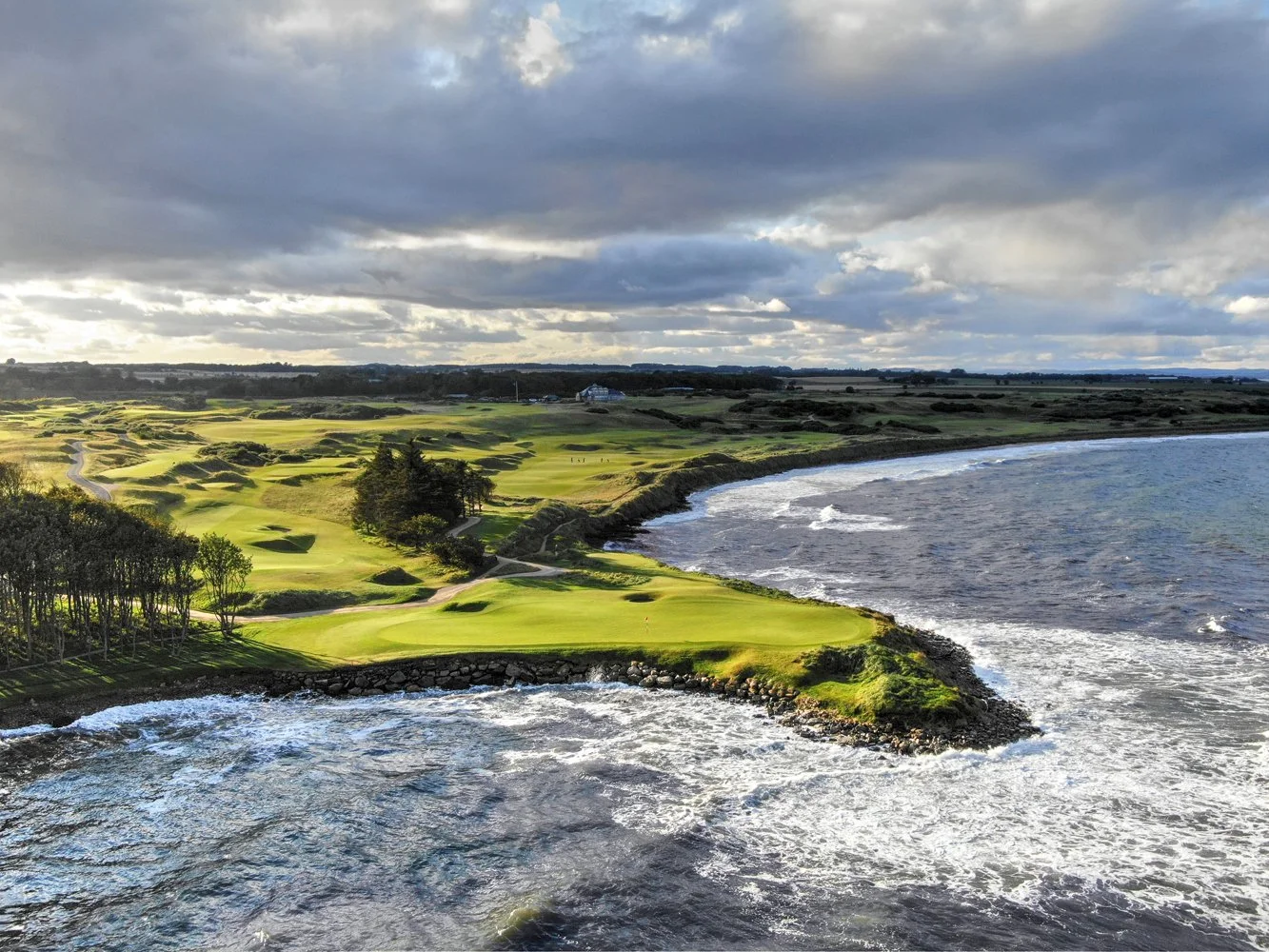Our Expert Guide to the St Andrews golf vacation package
A St Andrews golf vacation package is not a "golf trip." It is a pilgrimage. For the true student of the game, every other course in the world is a preface; this is the text itself. While other locations can claim to have "hit balls with sticks" , the small, windswept town on the coast of Fife is the spiritual, political, and historical epicenter of golf as we know it. To walk its links is to trace the very origins of the sport.
The story of St. Andrews is the story of golf. There are records of the game being played on these public links as early as the 1400s. It became so popular that it was seen as a threat to national security. In 1457, King James II of Scotland banned the game, believing his subjects were playing too much "gowff" instead of practicing their archery. The ban was upheld by James III, but golf was ultimately saved by a fellow enthusiast. In 1502, King James IV, a keen golfer himself, repealed the ban and was recorded purchasing his own clubs and balls to play at St. Andrews.
This royal pardon was followed by the single most important document in the history of public golf: the 1552 charter by Archbishop John Hamilton. This charter confirmed the rights of the "local populace" to use the links, establishing the foundational, enduring public nature of the Old Course.
For 200 years, the game evolved until, in 1754, a group of 22 noblemen, professors, and landowners founded the "Society of St Andrews Golfers" to organize their passion. This society would become The Royal and Ancient Golf Club (R&A). This is where the legend of St. Andrews was deliberately forged. The title "Home of Golf" was not a passive descriptor; it was an active, strategic claim. In 1834, King William IV recognized the society as "Royal and Ancient". Armed with this royal status, the Society "grandly proclaimed" St. Andrews as the "Home of Golf". This claim was solidified when the club was invited to codify the official rules of golf in 1897 and, for the next century, acted as the game's governing authority alongside the USGA.
The final pillar of its sanctity was its championship pedigree. The Open, golf's oldest major, first came to the Old Course in 1873. It is here that legends are made and measured. As Tiger Woods, a two-time Open Champion at St. Andrews, summarized it: "To win at St Andrews is the ultimate".
This is the ground to which the pilgrim is called. It is not just a place, but an idea—the very center of golf's organized, codified, and spiritual world.
The Pilgrim's Six: A Curated Bucket List Itinerary
St. Andrews has been called the "Metropolis of Golf". The town and the surrounding Kingdom of Fife are an embarrassment of riches, overflowing with "world-class links courses". A true pilgrimage, therefore, cannot be a single-minded quest for the Old Course. That is like visiting Paris to see the Eiffel Tower only from the ground.
A pilgrimage requires a curated itinerary that tells the entire story of golf. The "Pilgrim's Six" is not just a list; it is a narrative arc. It is a balanced diet of experiences that allows a golfer to walk through the complete history and evolution of the game.
An Evolved Masterpiece (Not "Designed")
The first and most crucial thing a pilgrim must understand is that the Old Course was not "designed" by a single architect. It was discovered. It has "no parallel". It evolved organically over centuries, shaped by the contours of the land and the traditions of the game.
For much of its life, it was played on the same set of fairways, out and back to the same holes. Its infamous "pot" bunkers were not, as legend holds, the result of cannon fire. They were created by sheep, which huddled for refuge from the wind in "sheltered areas," scraping away the grass and exposing the sand below.
The course as we know it took shape in two key moments. First, in 1764, the Society of St Andrews Golfers decided the first four (and last four) holes were too short. They combined them into two, reducing the 22-hole layout to 18. This decision set the 18-hole standard for the entire sport.
The second key moment came from its "architects," or more accurately, its custodians. While Daw Anderson made notable contributions in the 1850s , the course's modern layout is the work of Old Tom Morris. Appointed Keeper of the Green in 1865 , his most crucial act, around 1863, was to separate the 1st green from the 17th. This simple change created the 18-hole layout with 7 iconic double greens and 4 single greens (1, 9, 17, and 18) that remains today.
The Hallowed Landmarks: A Strategic Guide to Its Quirks
The Old Course is an "acquired taste". Its genius lies in its "strategic ambiguity". To the first-time player, it can be baffling, with few visible hazards from the tee. Its defenses are subtle, and its landmarks are hallowed ground.
The Double Greens: The most unique feature. The Old Course has seven massive, shared greens. Each services two holes, with the hole numbers always adding up to 18 (e.g., the 2nd and 16th, the 3rd and 15th). A well-struck approach to the correct hole can easily leave a 100-foot putt.
The 112 Bunkers: These are the true hazards. They are "hidden and pot" , not sprawling, visible traps. As one caddie noted, "Bunkers should be a hazard. They are a hazard here at St. Andrews. You need to avoid the bunkers at St. Andrews because you often can't play out of them". Many are named:
Hell Bunker: The 10-foot-deep chasm on the 14th hole.
The Coffins: A trio of small, deep bunkers on the 6th hole, "so named for their shape and the fact that if you go in one, you're pretty much dead".
Strath: A "vicious little pot bunker" guarding the par-3 11th, where tournament pin positions are often tucked right behind it.
Cheape's: A bunker on the 2nd hole named for James Cheape, the landowner who saved the links from being overrun by rabbit farmers in 1821.
The Road Hole (Hole 17): "Arguably the most famous hole" and "one of the most challenging par-4s in golf". It is a masterpiece of intimidation.
The Tee Shot: A blind shot over the sheds and the corner of the Old Course Hotel.
The Approach: A long iron to a perilously narrow green, guarded in front by the "Road Hole Bunker" and in back by a literal road and stone wall. The "Road Hole Bunker" is perhaps the most famous trap in golf. In 1978, Tommy Nakajima was in contention at The Open when he putted into it, taking four agonizing shots to get out and ending his chances. During the 2015 Open, the hole played to a 4.66 scoring average, making it the toughest hole on the entire PGA TOUR for the year.
The Swilcan Bridge & The Valley of Sin (Hole 18): The 1st and 18th fairways are a single, massive expanse of land. As you walk up the 18th, you cross the 700-year-old stone Swilcan Bridge , which spans the Swilcan Burn. This bridge is the site of golf's most iconic farewells, from Jack Nicklaus to Tiger Woods. The green is fronted by the "Valley of Sin," a deep, swale famous for Costantino Rocca's miraculous 65-foot putt in the 1995 Open to force a playoff.
Walking with Giants: The 30 Opens
It is impossible to separate the course from its history. It has hosted 30 Open Championships, more than any other venue. It is here that Bobby Jones, who tore up his card in frustration in 1921, returned to win in 1927 and fell in love with the town. He famously said that a player must win at St. Andrews to "be considered great".
The roll call of champions is a roll call of legends: Tom Kidd (1873) , Bobby Jones (1927) , Sam Snead (1946), Peter Thomson (1955), Jack Nicklaus (1970, 1978), Seve Ballesteros (1984), Sir Nick Faldo (1990), Tiger Woods (2000, 2005), and Cameron Smith (2022).
The Old Course selects its champions. Its "strategic ambiguity" 1 and "acquired taste" 2 demand a level of creative, intellectual, and strategic genius that baffles one-dimensional players. The greatest testament to this is Tiger Woods' 2000 victory. In a performance of supreme course management, he shot 19-under-par and famously did not hit his ball into a single one of the 112 bunkers.3 He did not overpower the Old Course; he out-thought it. When you play here, you are not just testing your swing; you are taking an IQ test designed by Mother Nature and refined by Old Tom Morris
St Andrews golf vacation package
This itinerary is built on a specific philosophy, balancing four crucial elements:
The Holy Grail: The non-negotiable spiritual center.
The Championship Gauntlet: The "brutal" test that defines the modern major.
The Modern Marvels: The 21st-century "experiential" masterpieces.
The Historic Gems: The "insider" courses for the purist and the historian.
This itinerary allows the pilgrim to physically walk through time. They will experience golf's 18th-century origins at Crail, its 19th-century codification and expansion at the Old and New Courses, its 20th-century "brutal" championship era at Carnoustie, and its 21st-century "experiential" evolution at Kingsbarns and Dumbarnie.
The Championship Gauntlet: Carnoustie ("Carnasty")
A pilgrimage to the "Home of Golf" is incomplete without a 45-minute drive north to the town of Angus. If the Old Course is the "Home," Carnoustie is the "examination hall". It is the foil to the Old Course, and it is the "test" of the pilgrimage.
"Golf's Greatest Test"
Carnoustie is widely and rightfully regarded as the "toughest course on the Open rota". Its nickname, "Carnasty," is hard-earned and well-deserved.
Like St. Andrews, its history is layered. Golf was played here as early as 1560. The first 10-hole course was laid out by St. Andrews' own Allan Robertson, with help from a young Old Tom Morris. Old Tom returned in 1867 to extend it to 18 holes. But the course that strikes fear into professionals today is largely the work of James Braid, who redesigned it in 1926.
Its championship resume is stellar, having hosted 8 Opens, 2 Women's Opens, and 2 Seniors Opens. The list of winners proves its difficulty. This is a course for grinders: Ben Hogan (1953), Gary Player (1968), Tom Watson (1975), Padraig Harrington (2007), and Francesco Molinari (2018).
Carnoustie is the antithesis of the Old Course. The Old Course is subtle, natural, and ambiguous, built on spectacular land. Carnoustie, by contrast, is an architectural masterpiece on a piece of land that is "not overly impressive". Its genius is its "world class routing" and its "finest examples of GCA" (Golf Course Architecture). It is "serious golf of the highest order" that poses a "relentless challenge". The Old Course charms you; Carnoustie interrogates you. A pilgrim must play it. To only play the St. Andrews courses is to miss the other side of championship links golf. You go to St. Andrews to be inspired; you go to Carnoustie to be tested.
The Gauntlet: A Guide to the Signature Holes
Hole 6, "Hogan's Alley": A 580-yard par-5. It is named for the legendary Ben Hogan, who, in his 1953 Open victory (his only Open appearance), hit the narrow slice of fairway between the left-side bunkers and the out-of-bounds fence on all four days. Gene Sarazen called it "the nearest approach to a perfect par 5 in the world".
Hole 14, "Spectacles": A monstrous par-5 (a par-4 for the 1968 Open ) named for two "fearsome" round bunkers that sit 50 yards short of the green, resembling a pair of eyeglasses. They demand a blind approach over them to a hidden green.
The Finishing Stretch (16, 17, 18): This is, without exaggeration, "the hardest stretch of three holes in golf". As one review notes, "You are never safe from a big score until you are on the green".
Hole 16, "Barry Burn": A "filthy" , "brutally long" 245-yard par-3. Tom Watson, a five-time Open champion, called it "the hardest par 3 in the world".
Holes 17 ("Island") & 18 ("Home"): The treacherous, winding Barry Burn crosses these final two holes multiple times. It is a psychological terror, waiting to "reduce you to your bare feet," as it did to Jean van de Velde in his infamous 1999 collapse. The 18th is one of the most demanding, dramatic, and nerve-shredding finishing holes in all of golf.
Opened in 2000, Kingsbarns Golf Links is located just 7 miles from St. Andrews. It is the "perfect example of modern links course design" and a "fabulous modern take" on the traditional game. It is sometimes called "Disney on Links" , and this is meant as a high compliment. It is a polished, 5-star, "wow" experience from start to finish.
The architect, Kyle Phillips, is a "master at extending what nature gives him". He "molded slopes, ridges and mounds that look indistinguishable from those formed naturally".
At Kingsbarns, it's "not just about the green fees—it's the whole package". The "service is first-class" , from the warm welcome to the practice facilities, the clubhouse, and the food. Its quality was instantly recognized, and it now co-hosts the annual Alfred Dunhill Links Championship (with the Old Course and Carnoustie) and hosted the 2017 Women's British Open.
KingsBarns Golf Links
The course itself is a "secluded golf paradise" where nearly every hole embraces the North Sea coastline.
Signature Holes:
Hole 12 (Par 5): A 606-yard monster with a "wonderful setting" that "hugs the ocean all the way around the dogleg left".
Hole 15 (Par 3): The "signature hole". The green appears to be a "frighteningly small target" on a peninsula, demanding a "long carry over the crashing waves and rocks".
Kingsbarns is the perfect complement to the Old Course. The Old Course is public, raw, and wonderfully quirky. Kingsbarns is polished, luxurious, and visually breathtaking. It is "fun" and "not the hardest course in the world". The pilgrim needs this day of modern, high-service luxury to balance the raw, historic feel of the other courses
St Andrews golf vacation package
Dumbarnie Links: The Newest Must-Play Spectacle
Opened in 2020, Dumbarnie Links, 11 miles south of St. Andrews , has in just a few short years become "one of the very best modern links" and an absolute "must-play bucket list" course.
The architect, Clive Clark, was given a "beautiful sandy site" and created a course "to inspire rather than intimidate". Like Kingsbarns, it is focused on "the whole package" and "stunning views".
Dumbarnie's unique selling proposition is its elevation and views. The 345-acre site has 1.5 miles of sea frontage and, crucially, "dual elevations" connected by a "flowing escarpment". This is not a flat links. Clark used this topography to create "a number of elevated tees" that play down towards "panoramic views" of the Firth of Forth. 14 of the 18 holes offer direct sea views. It's a "Pebble Beach" factor that is unique in the area.
The course is a "risk and reward" design , featuring wide, inviting fairways and three potentially driveable par-4s. Its quality was immediately validated when it was chosen to host the 2021 Women's Scottish Open
The New Course: The "Oldest New Course in the World"
The New Course is a glorious irony. Opened in 1895, it is anything but new. It sits adjacent to the Old Course, and its architect was none other than Old Tom Morris himself.
This is "a classic test of links golf". It is a traditional out-and-back routing , featuring gorse-lined, narrow fairways and tough, well-bunkered greens.
The New Course is the "local's secret" and the "purer test." It is, tellingly, "the most played course at St Andrews by the local members". It is "extremely underrated" because it lives in the shadow of its mythical neighbor. Many locals and purists consider it "fairer" and even "tougher" than the Old Course.
A pilgrim plays the Old Course for its history, magic, and "quirk". But they must play the New Course to understand the "purist's" version of St. Andrews links golf—the one Old Tom Morris designed from scratch. It is the insider's play, a "first-class golfing challenge" that may be one of the best golf experiences of the trip.
Crail (Balcomie Links): The Historic Gem (1786)
A 12-mile drive to the easternmost point of Fife brings the pilgrim to the Crail Golfing Society. This is a journey back to the genesis of the game. Founded in 1786, it is the 7th oldest golf club in the world.
The Balcomie Links was formally laid out by Old Tom Morris in 1895. The vibe is "old school". The clubhouse is a museum, and the "emphasis is very much on the fun factor". It is an "exhilarating seaside location" where every hole is "within sight of the sea".
The course is quirky, charming, and short: a 5,861-yard, par 69. Its unusual mix of 6 par-3s, 3 par-5s, and 9 par-4s tells of a time before "championship" length was the standard. The holes "track the shoreline" in a delightful routing.
Signature Holes:
Hole 5, "Hell's Hole": The "hardest hole on the course". A long par-4 that is a "perilous dogleg" forcing the player to decide "how much of the water are you willing to cut off?".
Hole 14, "The Cave": A "pastoral par three" and "links golf at its finest". It plays from a high, elevated tee down to a small, heavily bunkered green.
Crail is the antidote to Carnoustie. After the psychological pressure of the Old Course and the physical beating at "Carnasty" , the pilgrim needs a day of pure, joyous, scenic golf. Crail is "perfect for holiday golf" , "player-friendly" , and a "chance to let your hair down and enjoy the simplicities of golf". It is the perfect, charming, and historically profound end to a comprehensive pilgrimage








